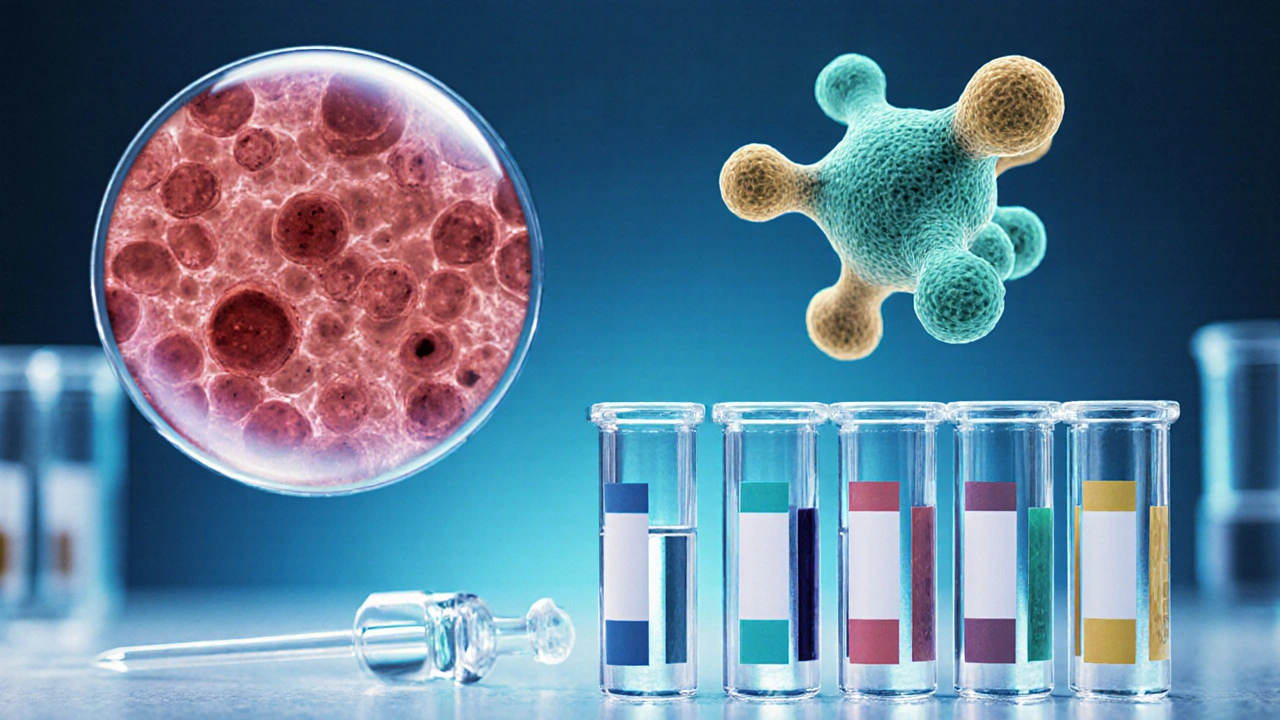Folate Deficiency in Seniors: Detection & Treatment Guide
 Oct, 6 2025
Oct, 6 2025
Folate Deficiency Risk Assessment
Please fill out the assessment questions and click "Assess Risk Level" to see your results.
When you see an older loved one feeling unusually tired, forgetful, or showing strange skin changes, it might be more than just ‘getting old.’ Folate deficiency quietly affects many seniors, but with the right clues and simple steps you can catch it early and fix it.
What Is Folate Deficiency?
Folate deficiency is a shortage of folate (vitamin B9), an essential nutrient that helps make DNA, red blood cells, and neurotransmitters. Without enough folate, the body can’t keep up with cell division, leading to a range of health problems.
Why Seniors Are at Higher Risk
People over 65 face several hurdles that make losing folate easier:
- Reduced stomach acid hampers the conversion of food folate to its active form.
- Medications such as proton‑pump inhibitors, diuretics, and metformin interfere with absorption.
- Dietary patterns often shift toward low‑fiber, processed foods that lack natural folate.
- Chronic conditions like kidney disease or alcoholism increase urinary loss of folate.
These factors combine to raise the odds of a deficiency by up to 30% compared with younger adults, according to a 2023 South African geriatric nutrition study.
Spotting the Signs
Folate deficiency can masquerade as many other age‑related complaints. Here are the most common red flags:
- Persistent fatigue that isn’t explained by activity level.
- Memory lapses or difficulty concentrating.
- Glossy, sore tongue (glossitis) and mouth ulcers.
- Shortness of breath during light exertion.
- Unexplained weight loss or loss of appetite.
- Macrocytic anemia - enlarged red blood cells that show up on a CBC.
When several of these appear together, especially the anemia, it’s time to run a lab check.

Lab Tests to Confirm
Two primary tests gauge folate status:
- Serum folate test measures the amount of folate circulating in the blood. Values below 3ng/mL suggest a recent deficiency.
- Red blood cell (RBC) folate test reflects longer‑term folate stores. Levels under 140ng/mL indicate chronic shortage.
Doctors also often order a homocysteine test because elevated homocysteine is a functional marker of low folate.
Homocysteine is an amino acid that climbs when folate, vitamin B12, or B6 are lacking. A result above 15µmol/L is a strong hint to check B‑vitamin status.
Cutting Through the Confusion: Folate vs. Vitamin B12
Both folate and vitamin B12 deficiencies cause macrocytic anemia and neurological signs, but the treatment paths differ. Below is a quick side‑by‑side comparison.
| Feature | Folate Deficiency | Vitamin B12 Deficiency |
|---|---|---|
| Typical labs | Low serum/RBC folate, high homocysteine, normal methylmalonic acid | Low B12, high homocysteine, high methylmalonic acid |
| Neurological symptoms | Rare, usually limited to fatigue and cognitive slowing | Peripheral neuropathy, balance problems, memory loss |
| Treatment | Folic acid 400‑800µg daily, dietary changes | Intramuscular B12 injections or high‑dose oral B12 |
| Response time | Hemoglobin improves in 1‑2weeks | Neurological recovery can take months or be incomplete |
Because the two can coexist, many clinicians order both folate and B12 panels to avoid missing a combined deficiency.
Treatment Options: Diet and Supplements
Once a deficiency is confirmed, the goal is to replenish stores quickly and then maintain them long‑term.
Dietary sources of folate
- Dark leafy greens - spinach, kale, collard greens (≈150µg per cup cooked)
- Legumes - lentils, chickpeas, black beans (≈180µg per half‑cup cooked)
- Citrus fruits - oranges, grapefruits (≈40µg per medium fruit)
- Fortified grains - breakfast cereals, wheat flour (≈140µg per serving)
- Eggs and liver - smaller amounts but highly bioavailable
Older adults often need a boost beyond food because appetite can be low and stomach absorption declines.
Folic acid supplementation
Folic acid is the synthetic form used in pills and fortified foods. The standard therapeutic dose for seniors is 400-800µg daily, taken with a meal to improve uptake.
Key considerations:
- Choose a brand that lists “folic acid” (not “folate”) for reliable dosing.
- If the senior is also taking anti‑convulsants or methotrexate, a higher dose (up to 1mg) might be prescribed.
- Monitor blood levels after 4‑6weeks; most labs will show a rise in RBC folate.
When to involve a healthcare professional
Always involve a doctor before starting high‑dose supplements, especially if the person has kidney disease, cancer, or is on anticoagulants. Excess folic acid can mask B12 deficiency, which may lead to irreversible nerve damage.

Practical Checklist for Seniors and Caregivers
- Watch for the symptom cluster listed above.
- Ask the doctor for a serum folate, RBC folate, and homocysteine panel.
- If results are low, start a 400µg folic acid supplement.
- Incorporate at least two folate‑rich foods into each daily meal.
- Re‑test after one month; aim for RBC folate >140ng/mL.
- Set a reminder to take the supplement with breakfast to improve adherence.
- Keep a log of energy levels, mood, and any side effects.
Following this simple routine can turn a hidden deficiency into a manageable part of everyday health.
Common Pitfalls & How to Avoid Them
- Self‑diagnosing with vague fatigue. Fatigue has many causes; always get lab confirmation.
- Skipping the B12 test. Because folate masks B12 deficiency, ordering both panels prevents mis‑treatment.
- Relying solely on fortified cereals. Processed foods may lack the fiber and other nutrients seniors need.
- Taking mega‑doses without monitoring. Excessive folic acid (>1mg) can hide B12 deficiency and interact with certain chemotherapy drugs.
- Ignoring medication interactions. Proton‑pump inhibitors and metformin lower folate absorption; discuss alternatives with a doctor.
By staying aware of these traps, seniors can safely restore their folate levels and keep their blood healthy.
Frequently Asked Questions
What daily amount of folic acid should a senior take?
Most experts recommend 400µg to 800µg per day, taken with food. The exact dose depends on the severity of the deficiency and any concurrent medications.
Can I get enough folate from diet alone?
A diet rich in leafy greens, beans, and fortified grains can meet the RDA (400µg) for most adults, but older people often need the extra boost from a supplement because of reduced absorption.
How long does it take to feel better after starting folic acid?
Energy and mood improvements are usually noticeable within 1‑2 weeks, while blood‑test results normalize in 4‑6 weeks.
Is there any risk of taking folic acid if I don’t have a deficiency?
Unnecessary high doses can mask an underlying vitamin B12 deficiency, potentially leading to nerve damage. Always test first.
Should I avoid any foods while supplementing?
There are no major food restrictions, but keep alcohol intake moderate because heavy drinking can increase folate loss.
Tim Ferguson
October 6, 2025 AT 19:40Folate deficiency in the elderly is a silent thief, stealing energy and focus while most of us are busy counting birthdays. The body’s ability to absorb folate drops with age, especially when meds like PPIs or metformin are in the mix. A simple blood test can spot the shortfall before it snowballs into anemia or cognitive fog. But the real irony? Most seniors never even think to ask for that test.
Noah Cokelaere
October 7, 2025 AT 15:06Wow, a whole assessment form for something you can check with a quick finger prick-because life’s not complicated enough, right? Still, if you’re already feeling like you’ve run out of steam, it might be worth the hassle.
Ashley Helton
October 8, 2025 AT 10:33Honestly, the form feels like a bureaucratic maze, but the advice about leafy greens? Spot on. A handful of spinach beats a pill any day.
Brian Jones
October 9, 2025 AT 06:00Folates are the unsung heroes of blood formation-yes, those red cells need them, and yes, seniors often miss out, especially when they’re on diuretics!!! The supplement dosage can be as low as 400µg, but some doctors push 800µg for safety-choose wisely!!!
Carlise Pretorius
October 10, 2025 AT 01:26Yo, just pop a multivitamin and you good.
Johnson Elijah
October 10, 2025 AT 20:53💊🧠 Keep those folate levels up, folks! A balanced diet + a tiny supplement can keep the brain sharp and the mood bright. 🌿✅
Roxanne Lemire
October 11, 2025 AT 16:20Folate helps make DNA and red blood cells it’s crucial for older adults especially when absorption slows down the guide mentions the 400‑800 microgram range which seems reasonable but always check with a doctor before adding pills
Alex Mitchell
October 12, 2025 AT 11:46Good point, thanks for the heads‑up! :)
Shweta Dandekar
October 13, 2025 AT 07:13It is ethically unacceptable to ignore a known deficiency that can cause real suffering!!! Everyone has a duty to get tested and to supplement responsibly!!!
Gary Smith
October 14, 2025 AT 02:40American seniors deserve the best health care, and that includes proper folate screening-let's make sure our system delivers!!!
Dominic Dale
October 14, 2025 AT 22:06When you read about folate deficiency in seniors, you have to wonder why the pharmaceutical industry pushes cheap synthetic supplements instead of promoting whole foods, because the profit margins on processed pills are astronomical and the control over distribution is razor‑sharp, the same way they control the narrative around vitamin D and calcium, it’s all part of a larger agenda to keep the population dependent on manufactured health solutions, consider the way certain labs receive funding from big pharma to develop “new” folate formulas that are patented, those patents lock out cheaper, natural alternatives, meanwhile, guidelines that recommend 400‑800 µg per day are conveniently vague, allowing doctors to prescribe branded versions that line their pockets, the hidden cost is not just monetary but also physiological, as synthetic folic acid can mask a B12 deficiency leading to irreversible nerve damage, this “masking” is a known side effect that the industry downplays, and the fact that the assessment tool asks about medications like PPIs and metformin hints at an awareness of drug‑nutrient interactions that the public is rarely educated about, yet the same companies market those drugs heavily, creating a feedback loop of dependency, the solution, of course, is to revert to a diet rich in leafy greens, beans, and fortified grains, but the modern food supply is saturated with processed items that lack these nutrients, so the cycle continues, in short, the whole folate conversation is a microcosm of how health information is curated to serve corporate interests rather than individual well‑being.
christopher werner
October 15, 2025 AT 17:33That perspective adds an interesting layer to the discussion, though the clinical recommendations still aim to improve outcomes for seniors.
Matthew Holmes
October 16, 2025 AT 13:00Folates are the quiet guardians of our blood and brain they work behind the scenes yet we neglect them until the damage is done
Patrick Price
October 17, 2025 AT 08:26Yo I kno u kinda think this is all hype but trust me the test is real and it can save u from feeling like crap
Travis Evans
October 18, 2025 AT 03:53Yo, squad, think of folate as the backstage crew that keeps the show running smooth-give your elders a little extra love with a daily boost and watch the energy bounce back like a fresh beat.